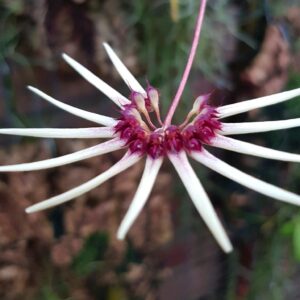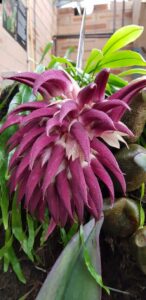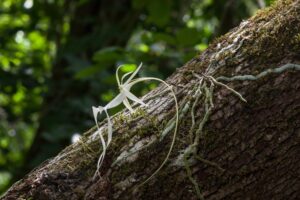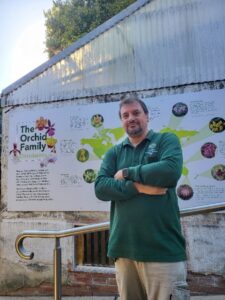
Orchids – plants with style
By Val Pintilie
Orchids are found on all continents of the world except Antarctica. The Orchidaceae family is the second biggest family in the plant world. There are known to be as many as 35,000 species of orchids and over 250,000 registered hybrids.

The widespread distribution of orchids in the world is replicated in our collection here at the Royal Botanic Gardens Sydney (RBGS). The orchid collection at RBGS represents orchids native to 86 countries from around the world with the balance between 70% species and 30% hybrids. The lowest number in our collection is the European region, and we really look forward to increasing the numbers of specimens in our collection.
The collection is divided into three different microclimates for our staff to manage. We tried to replicate a mountain climate, where the winter night-time temperature can drop as low as 5ºC and the maximum temperature in summer daytime will rise to a maximum of 4oC. The climate will mostly accommodate species of plants from tropical areas but situated at high altitude. Some countries include Peru, Bolivia, Brazil, and Chile.
Plants represented from this climate in our collection include species of Pescatoria, Restrepia, Masdevallia, Dracula, Xylobium, and Maxilaria. The total number of plants in this area is around 400 specimens.
Our Australian collections are placed in outdoor conditions in shaded and sunny positions, so, the variation in temperatures is between 8oC in winter and 36oC in summer. Plants in this area are species of Cymbidium, Dendrobium, Phaius, Sobralia and Coelogyne. The total number of plants in this area is around 200 specimens.
We have tried to replicate hot tropical conditions where the minimum temperature in the winter nights is kept at 19oC and the maximum temperature on hot summer days can rise to 45oC, associated of course with very high humidity (80-90%).
The plants in this microclimate come from North America, Central America, South America, Africa and Madagascar, Asia, and Australia. The total number of plants in this microclimate are around 1200.

Recently this area was renovated and can now accommodate many more species.
The main five genera we try to develop in the collection will be Bulbophyllum, Stanhopea, Dendrobium, Paphiopedilum and Phalaenopsis.

We know that we can`t accommodate all the species in the world (35,000), but we are always happy to have the rarest and unusual ones such as Dendrophylax lindenii.
The oldest specimens in the collection would be ones registered with RBG Nursery in 1978; Bulbophyllum baileyi, Epidendrum ciliare, Epidendrum peperomia, and Bulbophyllum fletcherianum.
Plants arrive in our collection via three ways. Some are purchased from different certified growers around Australia, through the exchange of material between Botanic Gardens, and through donations of some collected in the wild from different parts of the world.
Our staff who maintain the orchid collection endeavour to improve data collection – this has led to a new project including capturing flowers and characteristic data collection, timelapse photography of floral parts, and growing new specimens from flask.
The main objective will be to have detailed records as well as increased knowledge and information to relay to our visitors.
To book a tour see https://www.botanicgardens.org.au/whats-on/guided-walks
Also, you can stay in touch with us, or the newest flowers, via social media.
Instagram @Sydney_orchids_R
TikTok @Valeriu Razvan Pinti
